Detailed Report: Value Proposition Analysis of Angus Dairy Operations
VerifiedAdded on 2021/11/11
|11
|3218
|33
Report
AI Summary
This report provides a detailed analysis of Angus Dairy's business model and value proposition, focusing on how the company creates value for its internal and external stakeholders. The analysis begins with an overview of Angus Dairy's business model, highlighting its revenue generation strategies and profit distribution. It then delves into the concept of value proposition, examining how Angus Dairy differentiates itself from competitors. The report explores the company's strategic approaches, including human resource development and financial management, to deliver value to farmer members and co-operatives. Furthermore, the report applies Service-Dominant (S-D) logic to understand how Angus Dairy co-creates value through its organizational structure, people management, marketing, and financial practices. Key aspects of Angus Dairy, such as its structure, people management practices, marketing strategies, and financial management, are examined in relation to their impact on value proposition. The report concludes by emphasizing how Angus Dairy's focus on service logic, co-creation of value, and sustainability contributes to its overall success.
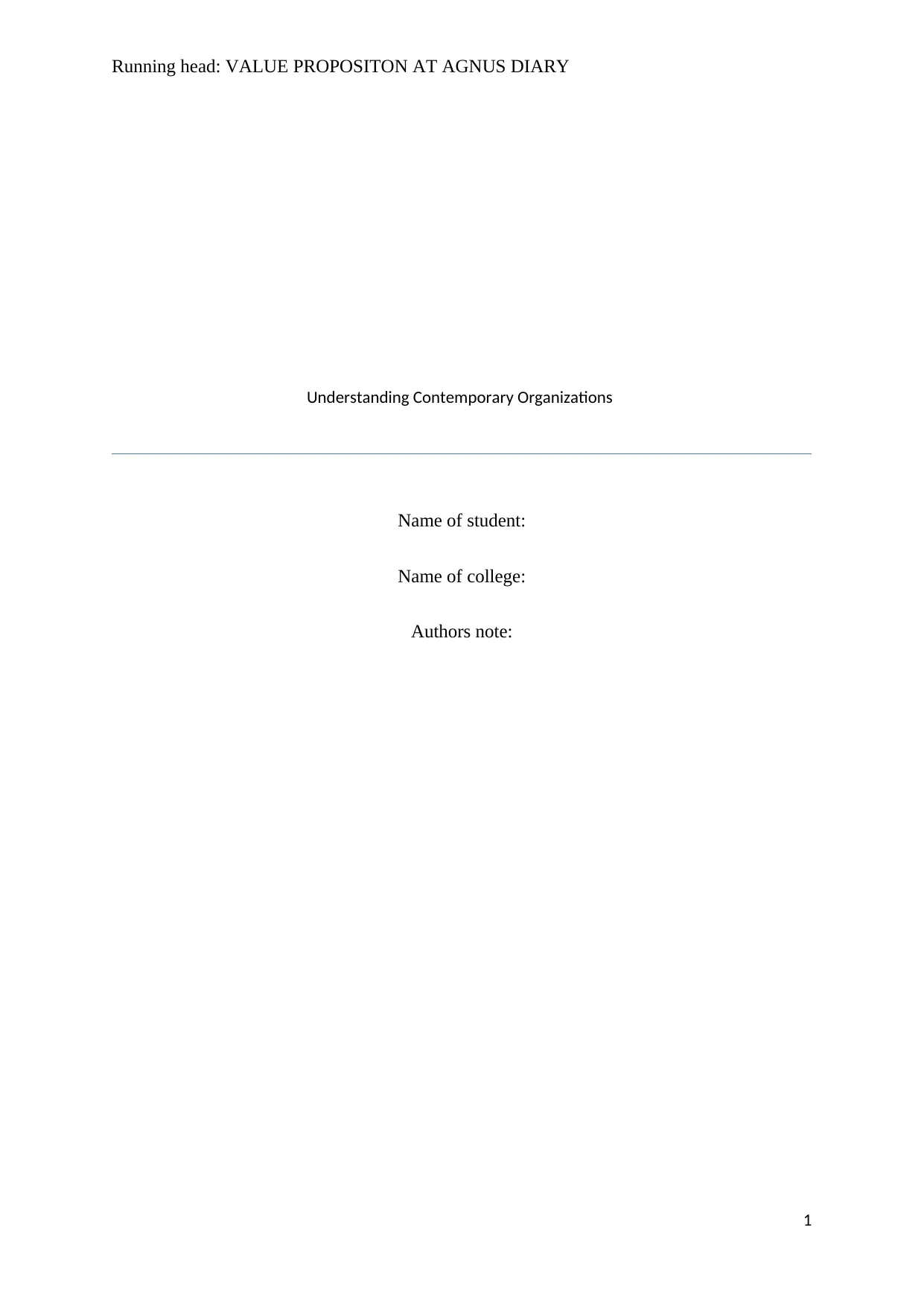
Running head: VALUE PROPOSITON AT AGNUS DIARY
Understanding Contemporary Organizations
Name of student:
Name of college:
Authors note:
1
Understanding Contemporary Organizations
Name of student:
Name of college:
Authors note:
1
Paraphrase This Document
Need a fresh take? Get an instant paraphrase of this document with our AI Paraphraser
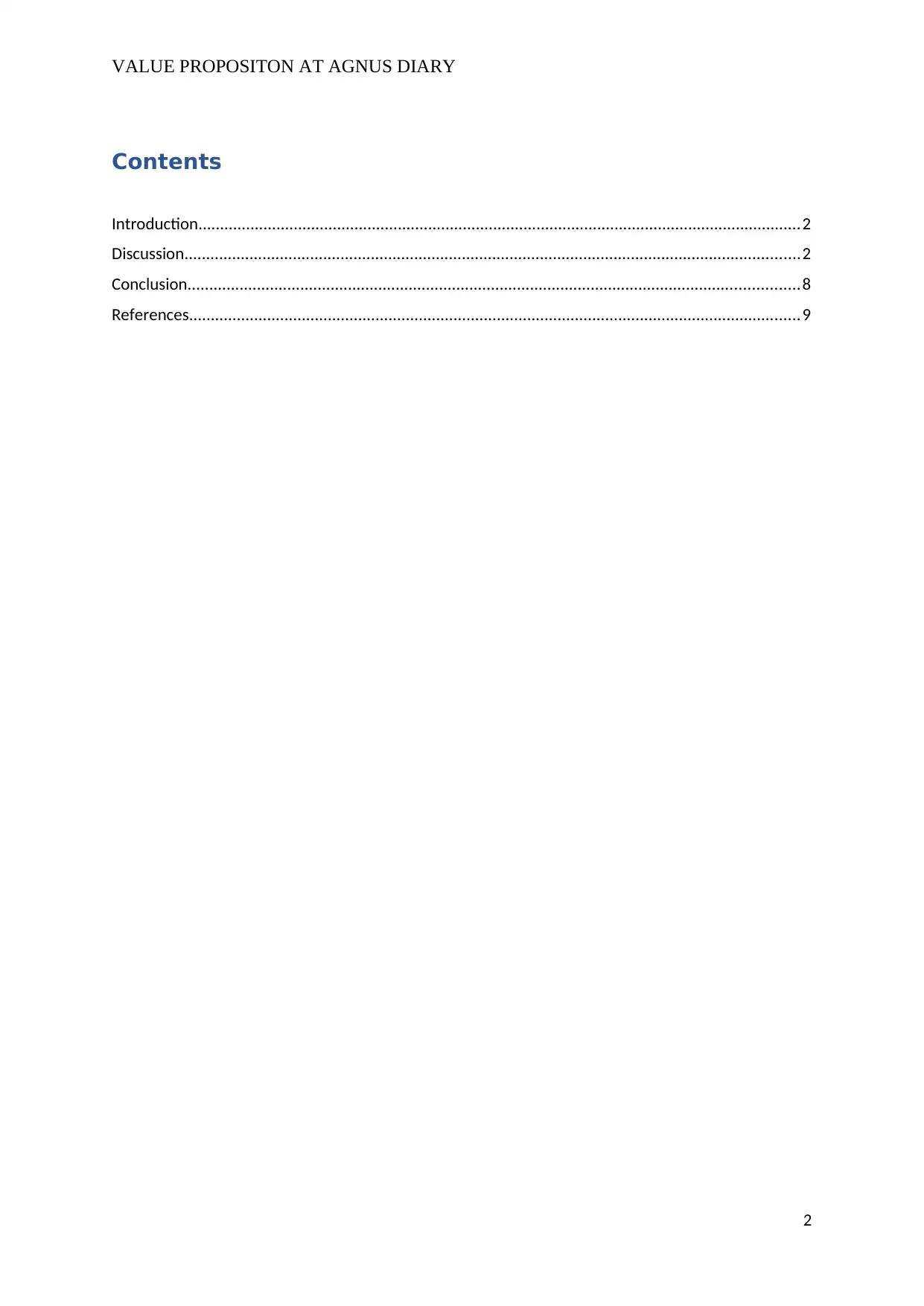
VALUE PROPOSITON AT AGNUS DIARY
Contents
Introduction...........................................................................................................................................2
Discussion..............................................................................................................................................2
Conclusion.............................................................................................................................................8
References.............................................................................................................................................9
2
Contents
Introduction...........................................................................................................................................2
Discussion..............................................................................................................................................2
Conclusion.............................................................................................................................................8
References.............................................................................................................................................9
2
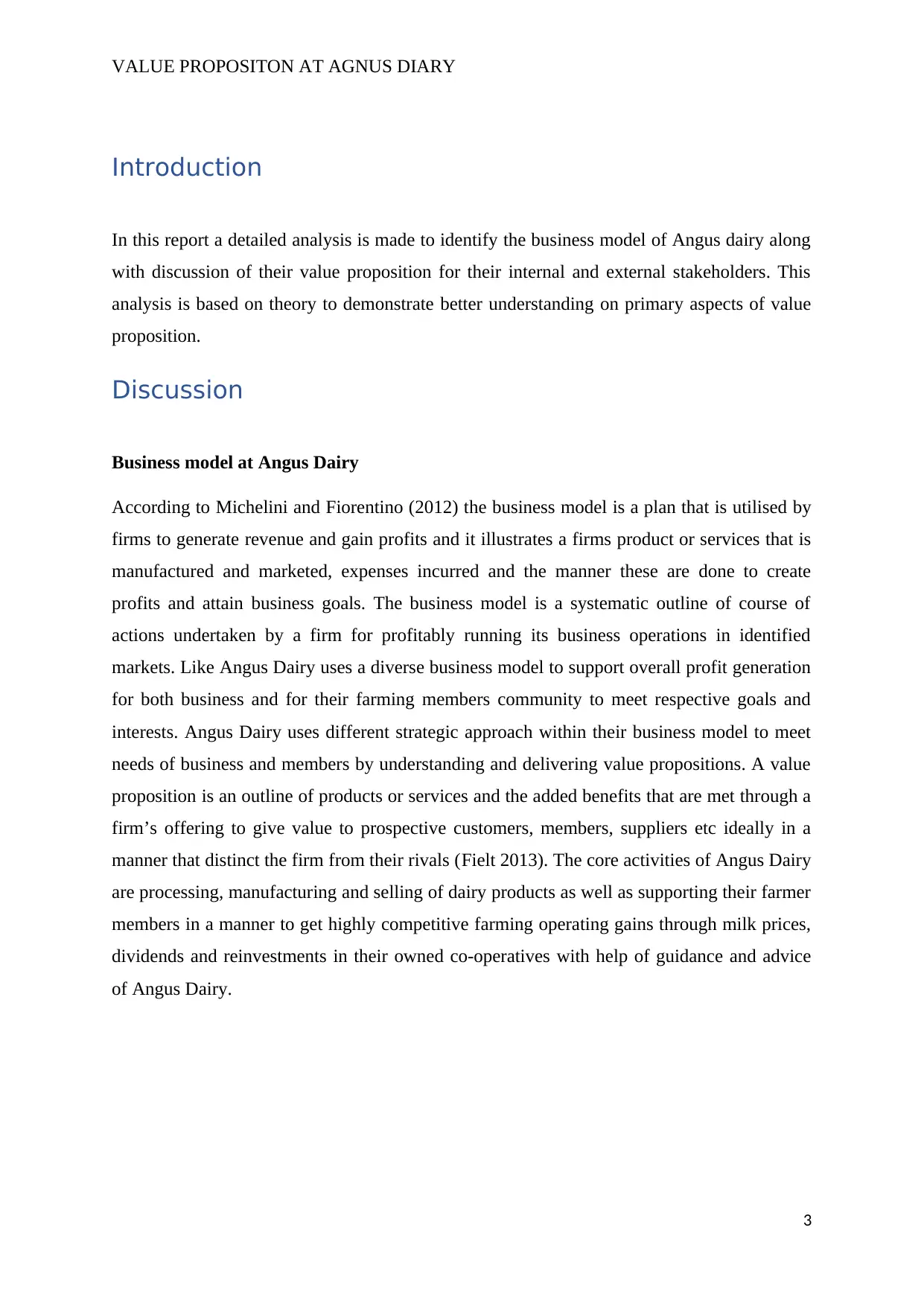
VALUE PROPOSITON AT AGNUS DIARY
Introduction
In this report a detailed analysis is made to identify the business model of Angus dairy along
with discussion of their value proposition for their internal and external stakeholders. This
analysis is based on theory to demonstrate better understanding on primary aspects of value
proposition.
Discussion
Business model at Angus Dairy
According to Michelini and Fiorentino (2012) the business model is a plan that is utilised by
firms to generate revenue and gain profits and it illustrates a firms product or services that is
manufactured and marketed, expenses incurred and the manner these are done to create
profits and attain business goals. The business model is a systematic outline of course of
actions undertaken by a firm for profitably running its business operations in identified
markets. Like Angus Dairy uses a diverse business model to support overall profit generation
for both business and for their farming members community to meet respective goals and
interests. Angus Dairy uses different strategic approach within their business model to meet
needs of business and members by understanding and delivering value propositions. A value
proposition is an outline of products or services and the added benefits that are met through a
firm’s offering to give value to prospective customers, members, suppliers etc ideally in a
manner that distinct the firm from their rivals (Fielt 2013). The core activities of Angus Dairy
are processing, manufacturing and selling of dairy products as well as supporting their farmer
members in a manner to get highly competitive farming operating gains through milk prices,
dividends and reinvestments in their owned co-operatives with help of guidance and advice
of Angus Dairy.
3
Introduction
In this report a detailed analysis is made to identify the business model of Angus dairy along
with discussion of their value proposition for their internal and external stakeholders. This
analysis is based on theory to demonstrate better understanding on primary aspects of value
proposition.
Discussion
Business model at Angus Dairy
According to Michelini and Fiorentino (2012) the business model is a plan that is utilised by
firms to generate revenue and gain profits and it illustrates a firms product or services that is
manufactured and marketed, expenses incurred and the manner these are done to create
profits and attain business goals. The business model is a systematic outline of course of
actions undertaken by a firm for profitably running its business operations in identified
markets. Like Angus Dairy uses a diverse business model to support overall profit generation
for both business and for their farming members community to meet respective goals and
interests. Angus Dairy uses different strategic approach within their business model to meet
needs of business and members by understanding and delivering value propositions. A value
proposition is an outline of products or services and the added benefits that are met through a
firm’s offering to give value to prospective customers, members, suppliers etc ideally in a
manner that distinct the firm from their rivals (Fielt 2013). The core activities of Angus Dairy
are processing, manufacturing and selling of dairy products as well as supporting their farmer
members in a manner to get highly competitive farming operating gains through milk prices,
dividends and reinvestments in their owned co-operatives with help of guidance and advice
of Angus Dairy.
3
⊘ This is a preview!⊘
Do you want full access?
Subscribe today to unlock all pages.

Trusted by 1+ million students worldwide
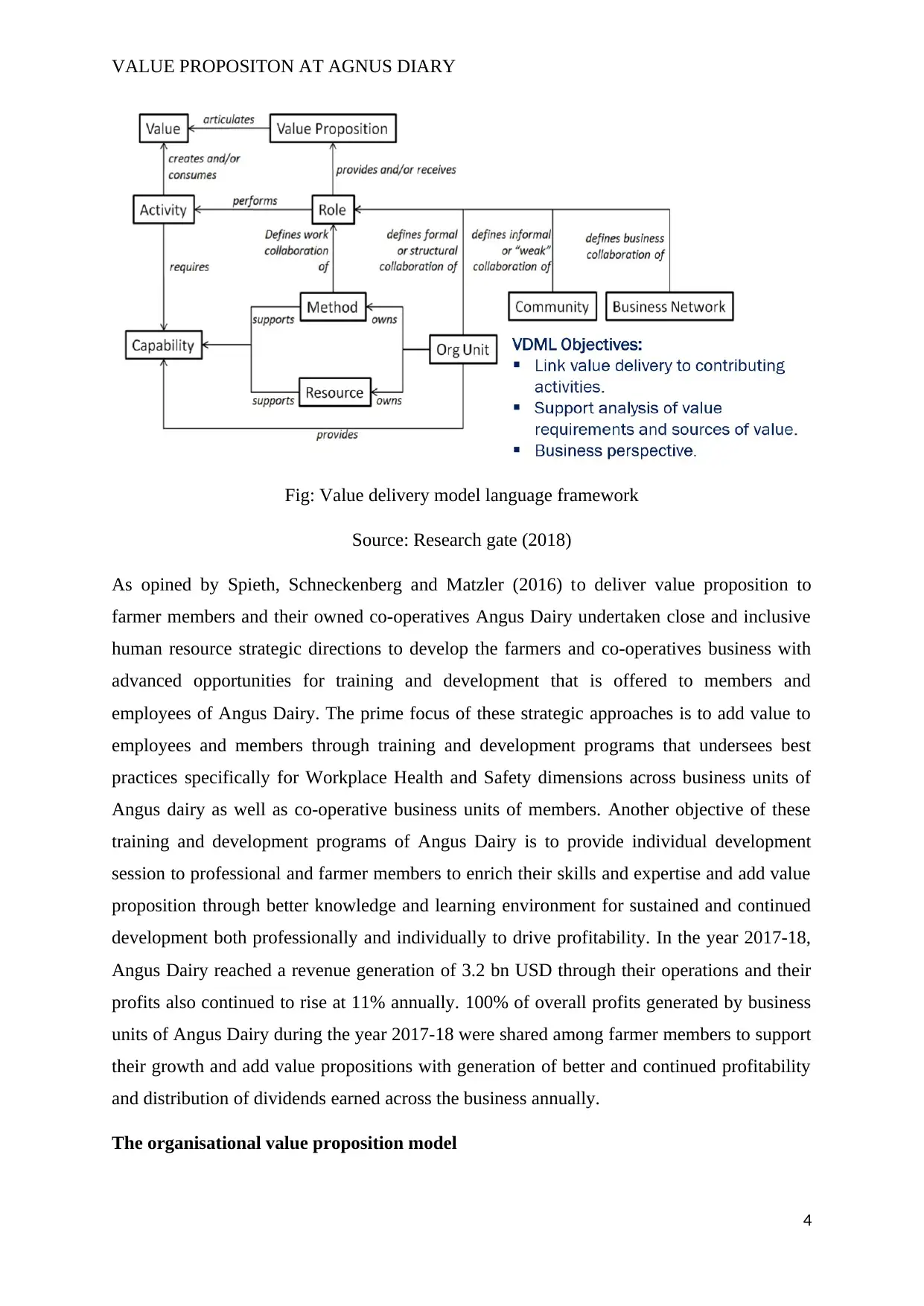
VALUE PROPOSITON AT AGNUS DIARY
Fig: Value delivery model language framework
Source: Research gate (2018)
As opined by Spieth, Schneckenberg and Matzler (2016) to deliver value proposition to
farmer members and their owned co-operatives Angus Dairy undertaken close and inclusive
human resource strategic directions to develop the farmers and co-operatives business with
advanced opportunities for training and development that is offered to members and
employees of Angus Dairy. The prime focus of these strategic approaches is to add value to
employees and members through training and development programs that undersees best
practices specifically for Workplace Health and Safety dimensions across business units of
Angus dairy as well as co-operative business units of members. Another objective of these
training and development programs of Angus Dairy is to provide individual development
session to professional and farmer members to enrich their skills and expertise and add value
proposition through better knowledge and learning environment for sustained and continued
development both professionally and individually to drive profitability. In the year 2017-18,
Angus Dairy reached a revenue generation of 3.2 bn USD through their operations and their
profits also continued to rise at 11% annually. 100% of overall profits generated by business
units of Angus Dairy during the year 2017-18 were shared among farmer members to support
their growth and add value propositions with generation of better and continued profitability
and distribution of dividends earned across the business annually.
The organisational value proposition model
4
Fig: Value delivery model language framework
Source: Research gate (2018)
As opined by Spieth, Schneckenberg and Matzler (2016) to deliver value proposition to
farmer members and their owned co-operatives Angus Dairy undertaken close and inclusive
human resource strategic directions to develop the farmers and co-operatives business with
advanced opportunities for training and development that is offered to members and
employees of Angus Dairy. The prime focus of these strategic approaches is to add value to
employees and members through training and development programs that undersees best
practices specifically for Workplace Health and Safety dimensions across business units of
Angus dairy as well as co-operative business units of members. Another objective of these
training and development programs of Angus Dairy is to provide individual development
session to professional and farmer members to enrich their skills and expertise and add value
proposition through better knowledge and learning environment for sustained and continued
development both professionally and individually to drive profitability. In the year 2017-18,
Angus Dairy reached a revenue generation of 3.2 bn USD through their operations and their
profits also continued to rise at 11% annually. 100% of overall profits generated by business
units of Angus Dairy during the year 2017-18 were shared among farmer members to support
their growth and add value propositions with generation of better and continued profitability
and distribution of dividends earned across the business annually.
The organisational value proposition model
4
Paraphrase This Document
Need a fresh take? Get an instant paraphrase of this document with our AI Paraphraser
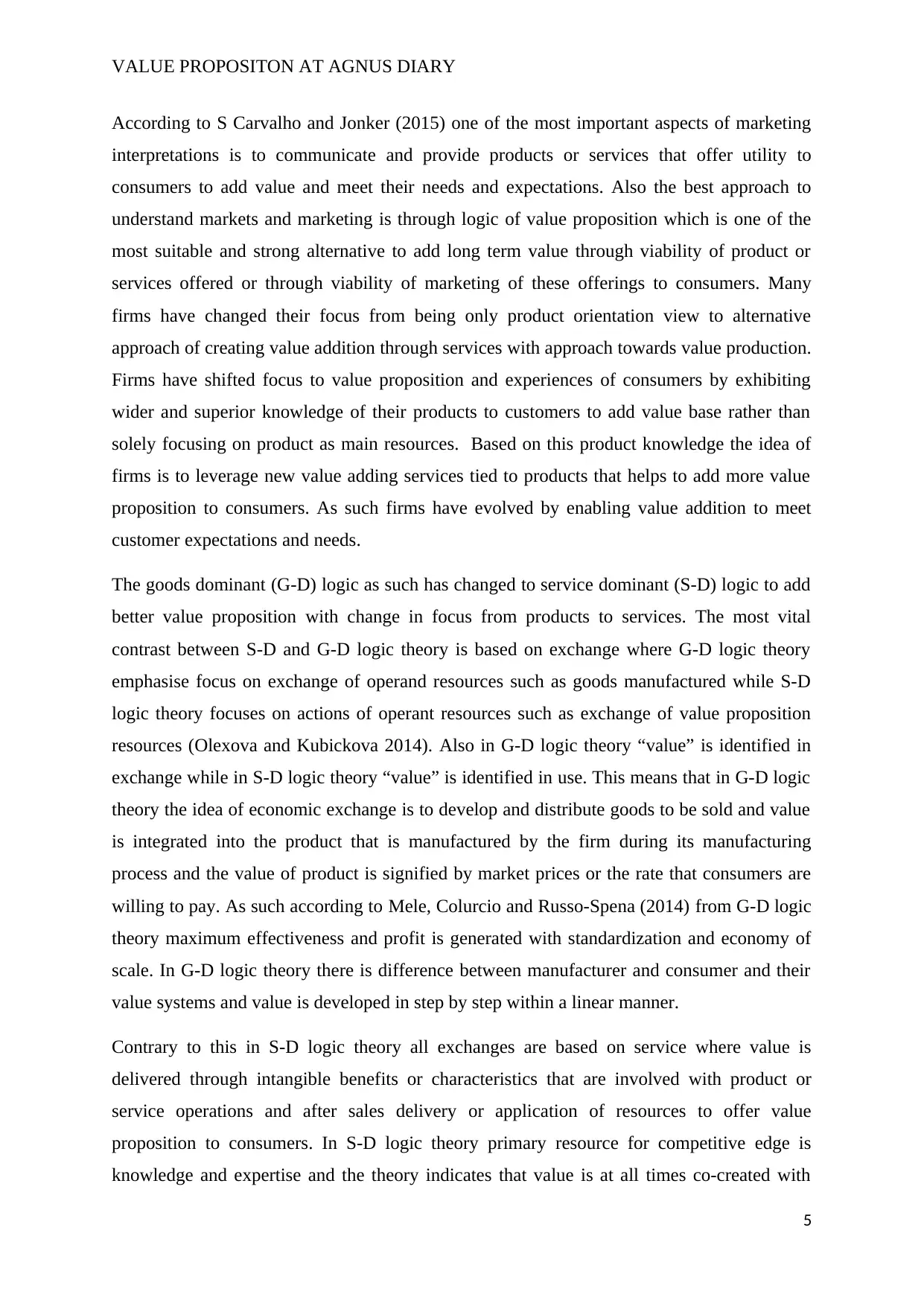
VALUE PROPOSITON AT AGNUS DIARY
According to S Carvalho and Jonker (2015) one of the most important aspects of marketing
interpretations is to communicate and provide products or services that offer utility to
consumers to add value and meet their needs and expectations. Also the best approach to
understand markets and marketing is through logic of value proposition which is one of the
most suitable and strong alternative to add long term value through viability of product or
services offered or through viability of marketing of these offerings to consumers. Many
firms have changed their focus from being only product orientation view to alternative
approach of creating value addition through services with approach towards value production.
Firms have shifted focus to value proposition and experiences of consumers by exhibiting
wider and superior knowledge of their products to customers to add value base rather than
solely focusing on product as main resources. Based on this product knowledge the idea of
firms is to leverage new value adding services tied to products that helps to add more value
proposition to consumers. As such firms have evolved by enabling value addition to meet
customer expectations and needs.
The goods dominant (G-D) logic as such has changed to service dominant (S-D) logic to add
better value proposition with change in focus from products to services. The most vital
contrast between S-D and G-D logic theory is based on exchange where G-D logic theory
emphasise focus on exchange of operand resources such as goods manufactured while S-D
logic theory focuses on actions of operant resources such as exchange of value proposition
resources (Olexova and Kubickova 2014). Also in G-D logic theory “value” is identified in
exchange while in S-D logic theory “value” is identified in use. This means that in G-D logic
theory the idea of economic exchange is to develop and distribute goods to be sold and value
is integrated into the product that is manufactured by the firm during its manufacturing
process and the value of product is signified by market prices or the rate that consumers are
willing to pay. As such according to Mele, Colurcio and Russo-Spena (2014) from G-D logic
theory maximum effectiveness and profit is generated with standardization and economy of
scale. In G-D logic theory there is difference between manufacturer and consumer and their
value systems and value is developed in step by step within a linear manner.
Contrary to this in S-D logic theory all exchanges are based on service where value is
delivered through intangible benefits or characteristics that are involved with product or
service operations and after sales delivery or application of resources to offer value
proposition to consumers. In S-D logic theory primary resource for competitive edge is
knowledge and expertise and the theory indicates that value is at all times co-created with
5
According to S Carvalho and Jonker (2015) one of the most important aspects of marketing
interpretations is to communicate and provide products or services that offer utility to
consumers to add value and meet their needs and expectations. Also the best approach to
understand markets and marketing is through logic of value proposition which is one of the
most suitable and strong alternative to add long term value through viability of product or
services offered or through viability of marketing of these offerings to consumers. Many
firms have changed their focus from being only product orientation view to alternative
approach of creating value addition through services with approach towards value production.
Firms have shifted focus to value proposition and experiences of consumers by exhibiting
wider and superior knowledge of their products to customers to add value base rather than
solely focusing on product as main resources. Based on this product knowledge the idea of
firms is to leverage new value adding services tied to products that helps to add more value
proposition to consumers. As such firms have evolved by enabling value addition to meet
customer expectations and needs.
The goods dominant (G-D) logic as such has changed to service dominant (S-D) logic to add
better value proposition with change in focus from products to services. The most vital
contrast between S-D and G-D logic theory is based on exchange where G-D logic theory
emphasise focus on exchange of operand resources such as goods manufactured while S-D
logic theory focuses on actions of operant resources such as exchange of value proposition
resources (Olexova and Kubickova 2014). Also in G-D logic theory “value” is identified in
exchange while in S-D logic theory “value” is identified in use. This means that in G-D logic
theory the idea of economic exchange is to develop and distribute goods to be sold and value
is integrated into the product that is manufactured by the firm during its manufacturing
process and the value of product is signified by market prices or the rate that consumers are
willing to pay. As such according to Mele, Colurcio and Russo-Spena (2014) from G-D logic
theory maximum effectiveness and profit is generated with standardization and economy of
scale. In G-D logic theory there is difference between manufacturer and consumer and their
value systems and value is developed in step by step within a linear manner.
Contrary to this in S-D logic theory all exchanges are based on service where value is
delivered through intangible benefits or characteristics that are involved with product or
service operations and after sales delivery or application of resources to offer value
proposition to consumers. In S-D logic theory primary resource for competitive edge is
knowledge and expertise and the theory indicates that value is at all times co-created with
5
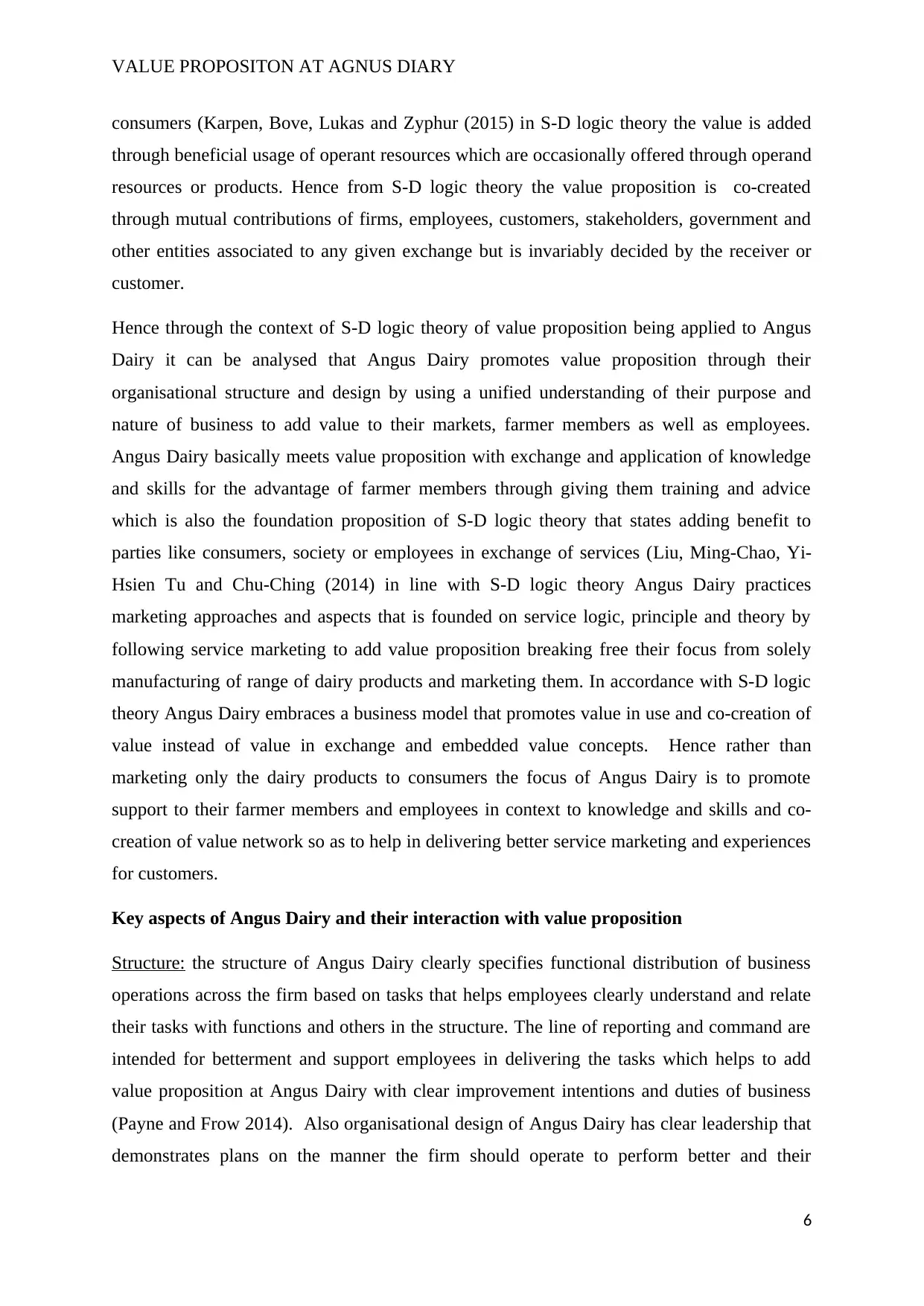
VALUE PROPOSITON AT AGNUS DIARY
consumers (Karpen, Bove, Lukas and Zyphur (2015) in S-D logic theory the value is added
through beneficial usage of operant resources which are occasionally offered through operand
resources or products. Hence from S-D logic theory the value proposition is co-created
through mutual contributions of firms, employees, customers, stakeholders, government and
other entities associated to any given exchange but is invariably decided by the receiver or
customer.
Hence through the context of S-D logic theory of value proposition being applied to Angus
Dairy it can be analysed that Angus Dairy promotes value proposition through their
organisational structure and design by using a unified understanding of their purpose and
nature of business to add value to their markets, farmer members as well as employees.
Angus Dairy basically meets value proposition with exchange and application of knowledge
and skills for the advantage of farmer members through giving them training and advice
which is also the foundation proposition of S-D logic theory that states adding benefit to
parties like consumers, society or employees in exchange of services (Liu, Ming-Chao, Yi-
Hsien Tu and Chu-Ching (2014) in line with S-D logic theory Angus Dairy practices
marketing approaches and aspects that is founded on service logic, principle and theory by
following service marketing to add value proposition breaking free their focus from solely
manufacturing of range of dairy products and marketing them. In accordance with S-D logic
theory Angus Dairy embraces a business model that promotes value in use and co-creation of
value instead of value in exchange and embedded value concepts. Hence rather than
marketing only the dairy products to consumers the focus of Angus Dairy is to promote
support to their farmer members and employees in context to knowledge and skills and co-
creation of value network so as to help in delivering better service marketing and experiences
for customers.
Key aspects of Angus Dairy and their interaction with value proposition
Structure: the structure of Angus Dairy clearly specifies functional distribution of business
operations across the firm based on tasks that helps employees clearly understand and relate
their tasks with functions and others in the structure. The line of reporting and command are
intended for betterment and support employees in delivering the tasks which helps to add
value proposition at Angus Dairy with clear improvement intentions and duties of business
(Payne and Frow 2014). Also organisational design of Angus Dairy has clear leadership that
demonstrates plans on the manner the firm should operate to perform better and their
6
consumers (Karpen, Bove, Lukas and Zyphur (2015) in S-D logic theory the value is added
through beneficial usage of operant resources which are occasionally offered through operand
resources or products. Hence from S-D logic theory the value proposition is co-created
through mutual contributions of firms, employees, customers, stakeholders, government and
other entities associated to any given exchange but is invariably decided by the receiver or
customer.
Hence through the context of S-D logic theory of value proposition being applied to Angus
Dairy it can be analysed that Angus Dairy promotes value proposition through their
organisational structure and design by using a unified understanding of their purpose and
nature of business to add value to their markets, farmer members as well as employees.
Angus Dairy basically meets value proposition with exchange and application of knowledge
and skills for the advantage of farmer members through giving them training and advice
which is also the foundation proposition of S-D logic theory that states adding benefit to
parties like consumers, society or employees in exchange of services (Liu, Ming-Chao, Yi-
Hsien Tu and Chu-Ching (2014) in line with S-D logic theory Angus Dairy practices
marketing approaches and aspects that is founded on service logic, principle and theory by
following service marketing to add value proposition breaking free their focus from solely
manufacturing of range of dairy products and marketing them. In accordance with S-D logic
theory Angus Dairy embraces a business model that promotes value in use and co-creation of
value instead of value in exchange and embedded value concepts. Hence rather than
marketing only the dairy products to consumers the focus of Angus Dairy is to promote
support to their farmer members and employees in context to knowledge and skills and co-
creation of value network so as to help in delivering better service marketing and experiences
for customers.
Key aspects of Angus Dairy and their interaction with value proposition
Structure: the structure of Angus Dairy clearly specifies functional distribution of business
operations across the firm based on tasks that helps employees clearly understand and relate
their tasks with functions and others in the structure. The line of reporting and command are
intended for betterment and support employees in delivering the tasks which helps to add
value proposition at Angus Dairy with clear improvement intentions and duties of business
(Payne and Frow 2014). Also organisational design of Angus Dairy has clear leadership that
demonstrates plans on the manner the firm should operate to perform better and their
6
⊘ This is a preview!⊘
Do you want full access?
Subscribe today to unlock all pages.

Trusted by 1+ million students worldwide
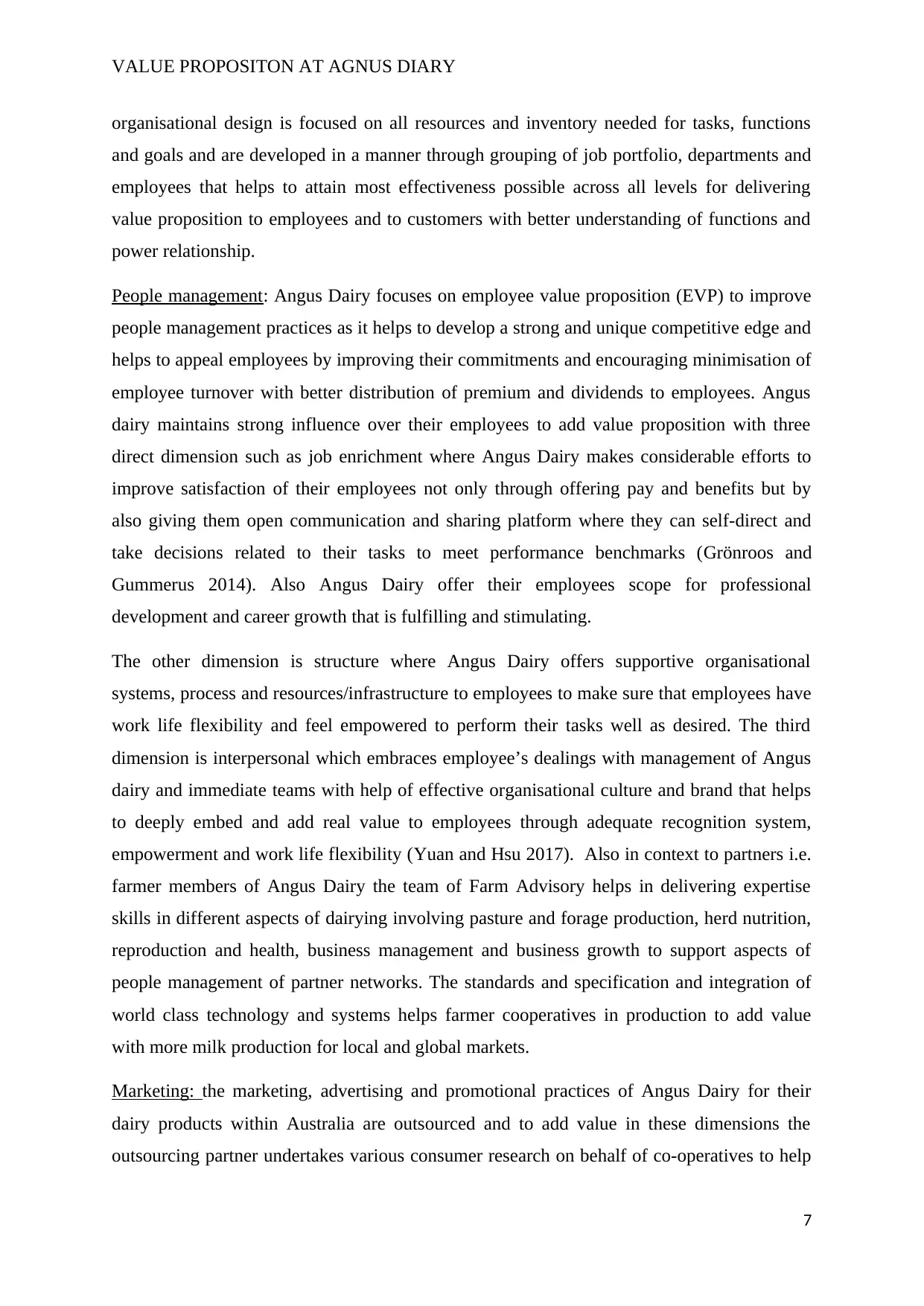
VALUE PROPOSITON AT AGNUS DIARY
organisational design is focused on all resources and inventory needed for tasks, functions
and goals and are developed in a manner through grouping of job portfolio, departments and
employees that helps to attain most effectiveness possible across all levels for delivering
value proposition to employees and to customers with better understanding of functions and
power relationship.
People management: Angus Dairy focuses on employee value proposition (EVP) to improve
people management practices as it helps to develop a strong and unique competitive edge and
helps to appeal employees by improving their commitments and encouraging minimisation of
employee turnover with better distribution of premium and dividends to employees. Angus
dairy maintains strong influence over their employees to add value proposition with three
direct dimension such as job enrichment where Angus Dairy makes considerable efforts to
improve satisfaction of their employees not only through offering pay and benefits but by
also giving them open communication and sharing platform where they can self-direct and
take decisions related to their tasks to meet performance benchmarks (Grönroos and
Gummerus 2014). Also Angus Dairy offer their employees scope for professional
development and career growth that is fulfilling and stimulating.
The other dimension is structure where Angus Dairy offers supportive organisational
systems, process and resources/infrastructure to employees to make sure that employees have
work life flexibility and feel empowered to perform their tasks well as desired. The third
dimension is interpersonal which embraces employee’s dealings with management of Angus
dairy and immediate teams with help of effective organisational culture and brand that helps
to deeply embed and add real value to employees through adequate recognition system,
empowerment and work life flexibility (Yuan and Hsu 2017). Also in context to partners i.e.
farmer members of Angus Dairy the team of Farm Advisory helps in delivering expertise
skills in different aspects of dairying involving pasture and forage production, herd nutrition,
reproduction and health, business management and business growth to support aspects of
people management of partner networks. The standards and specification and integration of
world class technology and systems helps farmer cooperatives in production to add value
with more milk production for local and global markets.
Marketing: the marketing, advertising and promotional practices of Angus Dairy for their
dairy products within Australia are outsourced and to add value in these dimensions the
outsourcing partner undertakes various consumer research on behalf of co-operatives to help
7
organisational design is focused on all resources and inventory needed for tasks, functions
and goals and are developed in a manner through grouping of job portfolio, departments and
employees that helps to attain most effectiveness possible across all levels for delivering
value proposition to employees and to customers with better understanding of functions and
power relationship.
People management: Angus Dairy focuses on employee value proposition (EVP) to improve
people management practices as it helps to develop a strong and unique competitive edge and
helps to appeal employees by improving their commitments and encouraging minimisation of
employee turnover with better distribution of premium and dividends to employees. Angus
dairy maintains strong influence over their employees to add value proposition with three
direct dimension such as job enrichment where Angus Dairy makes considerable efforts to
improve satisfaction of their employees not only through offering pay and benefits but by
also giving them open communication and sharing platform where they can self-direct and
take decisions related to their tasks to meet performance benchmarks (Grönroos and
Gummerus 2014). Also Angus Dairy offer their employees scope for professional
development and career growth that is fulfilling and stimulating.
The other dimension is structure where Angus Dairy offers supportive organisational
systems, process and resources/infrastructure to employees to make sure that employees have
work life flexibility and feel empowered to perform their tasks well as desired. The third
dimension is interpersonal which embraces employee’s dealings with management of Angus
dairy and immediate teams with help of effective organisational culture and brand that helps
to deeply embed and add real value to employees through adequate recognition system,
empowerment and work life flexibility (Yuan and Hsu 2017). Also in context to partners i.e.
farmer members of Angus Dairy the team of Farm Advisory helps in delivering expertise
skills in different aspects of dairying involving pasture and forage production, herd nutrition,
reproduction and health, business management and business growth to support aspects of
people management of partner networks. The standards and specification and integration of
world class technology and systems helps farmer cooperatives in production to add value
with more milk production for local and global markets.
Marketing: the marketing, advertising and promotional practices of Angus Dairy for their
dairy products within Australia are outsourced and to add value in these dimensions the
outsourcing partner undertakes various consumer research on behalf of co-operatives to help
7
Paraphrase This Document
Need a fresh take? Get an instant paraphrase of this document with our AI Paraphraser
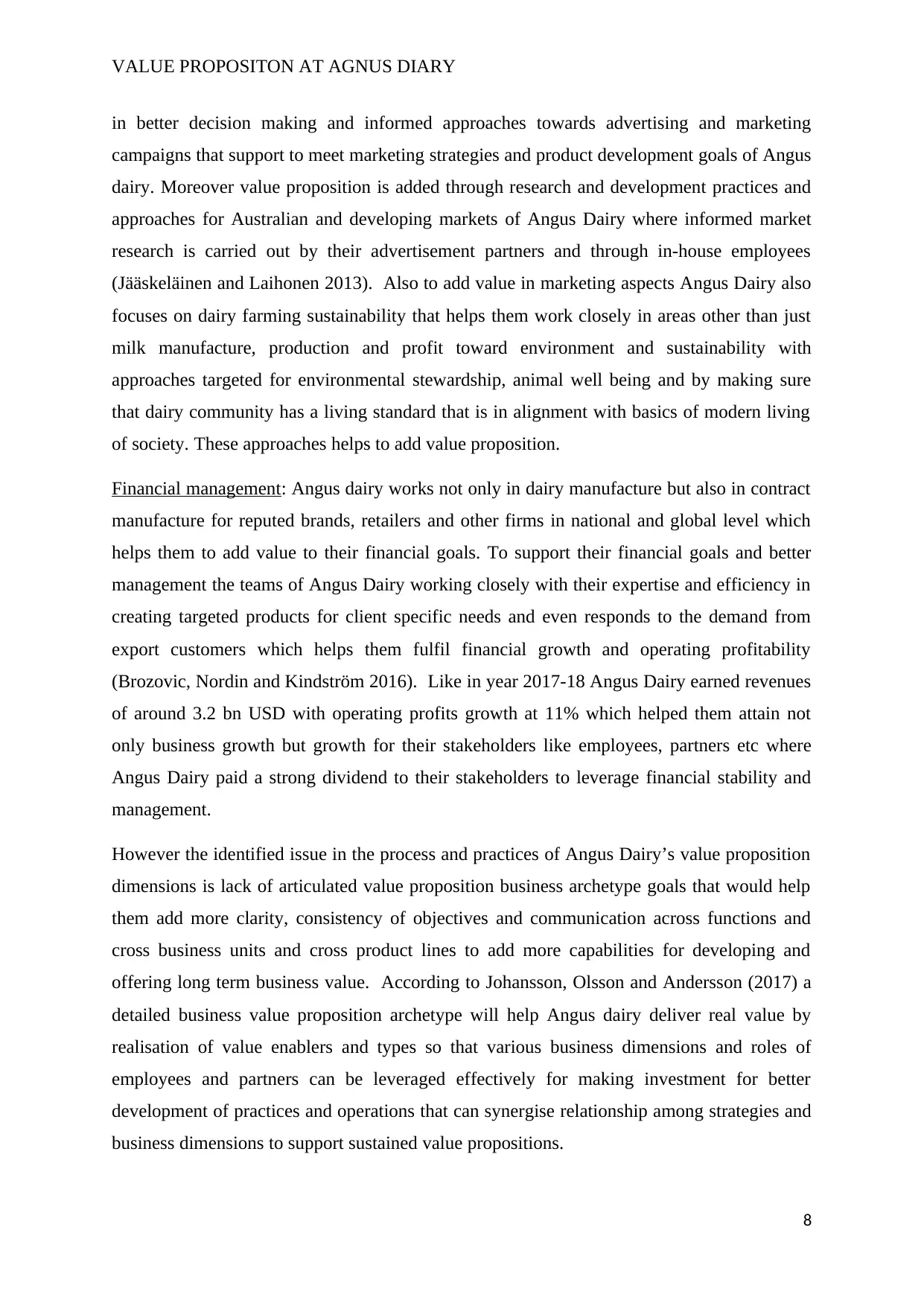
VALUE PROPOSITON AT AGNUS DIARY
in better decision making and informed approaches towards advertising and marketing
campaigns that support to meet marketing strategies and product development goals of Angus
dairy. Moreover value proposition is added through research and development practices and
approaches for Australian and developing markets of Angus Dairy where informed market
research is carried out by their advertisement partners and through in-house employees
(Jääskeläinen and Laihonen 2013). Also to add value in marketing aspects Angus Dairy also
focuses on dairy farming sustainability that helps them work closely in areas other than just
milk manufacture, production and profit toward environment and sustainability with
approaches targeted for environmental stewardship, animal well being and by making sure
that dairy community has a living standard that is in alignment with basics of modern living
of society. These approaches helps to add value proposition.
Financial management: Angus dairy works not only in dairy manufacture but also in contract
manufacture for reputed brands, retailers and other firms in national and global level which
helps them to add value to their financial goals. To support their financial goals and better
management the teams of Angus Dairy working closely with their expertise and efficiency in
creating targeted products for client specific needs and even responds to the demand from
export customers which helps them fulfil financial growth and operating profitability
(Brozovic, Nordin and Kindström 2016). Like in year 2017-18 Angus Dairy earned revenues
of around 3.2 bn USD with operating profits growth at 11% which helped them attain not
only business growth but growth for their stakeholders like employees, partners etc where
Angus Dairy paid a strong dividend to their stakeholders to leverage financial stability and
management.
However the identified issue in the process and practices of Angus Dairy’s value proposition
dimensions is lack of articulated value proposition business archetype goals that would help
them add more clarity, consistency of objectives and communication across functions and
cross business units and cross product lines to add more capabilities for developing and
offering long term business value. According to Johansson, Olsson and Andersson (2017) a
detailed business value proposition archetype will help Angus dairy deliver real value by
realisation of value enablers and types so that various business dimensions and roles of
employees and partners can be leveraged effectively for making investment for better
development of practices and operations that can synergise relationship among strategies and
business dimensions to support sustained value propositions.
8
in better decision making and informed approaches towards advertising and marketing
campaigns that support to meet marketing strategies and product development goals of Angus
dairy. Moreover value proposition is added through research and development practices and
approaches for Australian and developing markets of Angus Dairy where informed market
research is carried out by their advertisement partners and through in-house employees
(Jääskeläinen and Laihonen 2013). Also to add value in marketing aspects Angus Dairy also
focuses on dairy farming sustainability that helps them work closely in areas other than just
milk manufacture, production and profit toward environment and sustainability with
approaches targeted for environmental stewardship, animal well being and by making sure
that dairy community has a living standard that is in alignment with basics of modern living
of society. These approaches helps to add value proposition.
Financial management: Angus dairy works not only in dairy manufacture but also in contract
manufacture for reputed brands, retailers and other firms in national and global level which
helps them to add value to their financial goals. To support their financial goals and better
management the teams of Angus Dairy working closely with their expertise and efficiency in
creating targeted products for client specific needs and even responds to the demand from
export customers which helps them fulfil financial growth and operating profitability
(Brozovic, Nordin and Kindström 2016). Like in year 2017-18 Angus Dairy earned revenues
of around 3.2 bn USD with operating profits growth at 11% which helped them attain not
only business growth but growth for their stakeholders like employees, partners etc where
Angus Dairy paid a strong dividend to their stakeholders to leverage financial stability and
management.
However the identified issue in the process and practices of Angus Dairy’s value proposition
dimensions is lack of articulated value proposition business archetype goals that would help
them add more clarity, consistency of objectives and communication across functions and
cross business units and cross product lines to add more capabilities for developing and
offering long term business value. According to Johansson, Olsson and Andersson (2017) a
detailed business value proposition archetype will help Angus dairy deliver real value by
realisation of value enablers and types so that various business dimensions and roles of
employees and partners can be leveraged effectively for making investment for better
development of practices and operations that can synergise relationship among strategies and
business dimensions to support sustained value propositions.
8
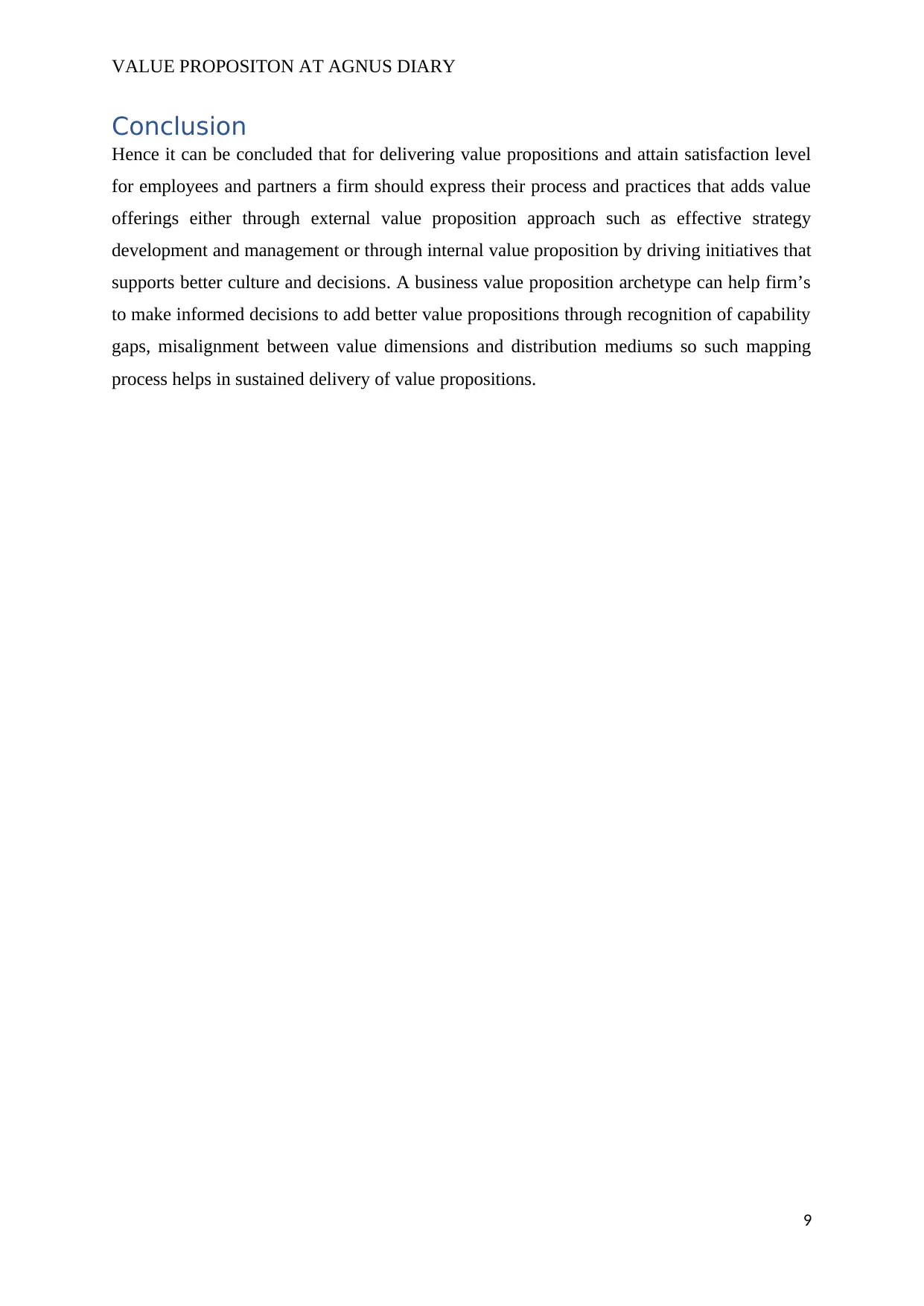
VALUE PROPOSITON AT AGNUS DIARY
Conclusion
Hence it can be concluded that for delivering value propositions and attain satisfaction level
for employees and partners a firm should express their process and practices that adds value
offerings either through external value proposition approach such as effective strategy
development and management or through internal value proposition by driving initiatives that
supports better culture and decisions. A business value proposition archetype can help firm’s
to make informed decisions to add better value propositions through recognition of capability
gaps, misalignment between value dimensions and distribution mediums so such mapping
process helps in sustained delivery of value propositions.
9
Conclusion
Hence it can be concluded that for delivering value propositions and attain satisfaction level
for employees and partners a firm should express their process and practices that adds value
offerings either through external value proposition approach such as effective strategy
development and management or through internal value proposition by driving initiatives that
supports better culture and decisions. A business value proposition archetype can help firm’s
to make informed decisions to add better value propositions through recognition of capability
gaps, misalignment between value dimensions and distribution mediums so such mapping
process helps in sustained delivery of value propositions.
9
⊘ This is a preview!⊘
Do you want full access?
Subscribe today to unlock all pages.

Trusted by 1+ million students worldwide
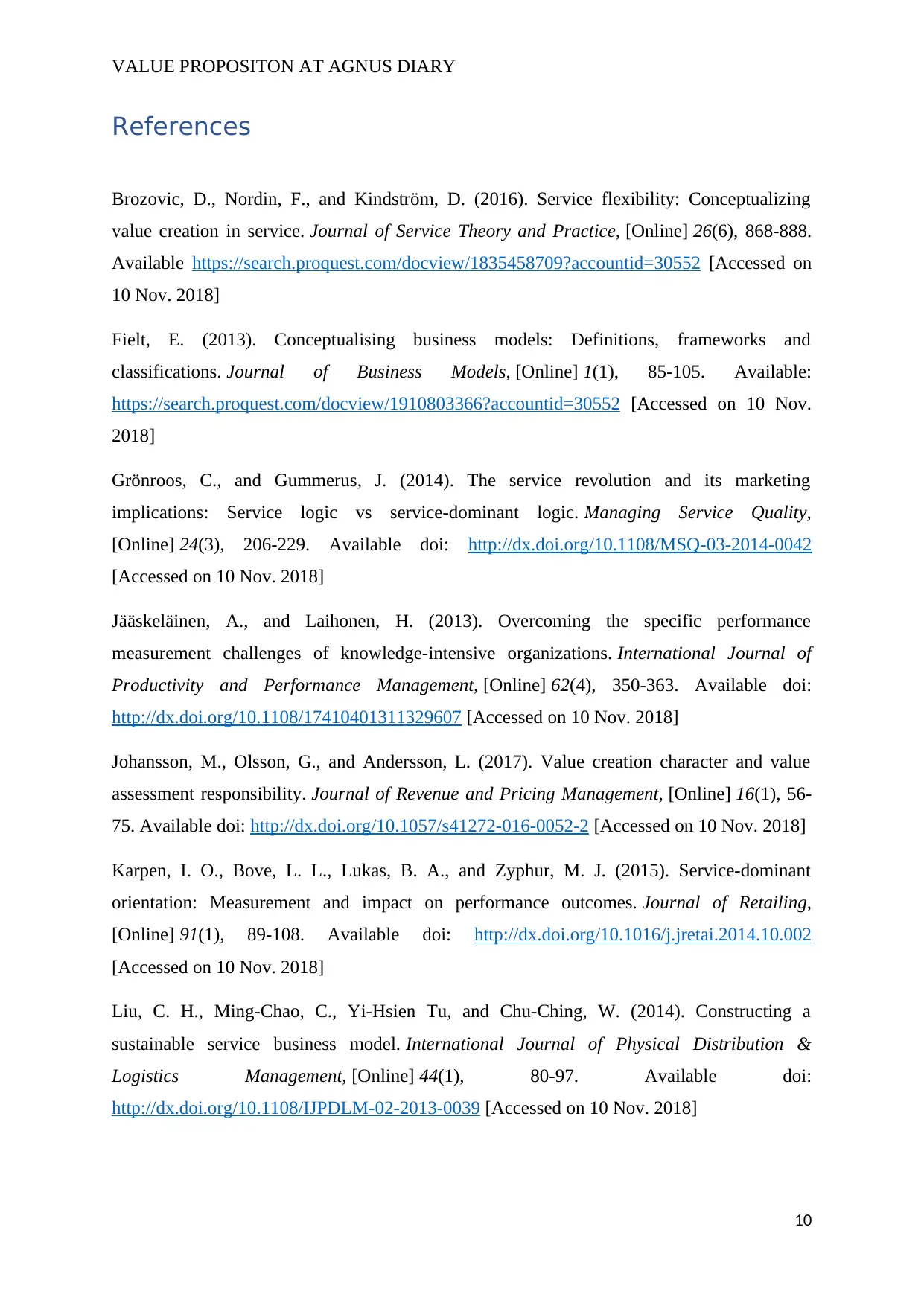
VALUE PROPOSITON AT AGNUS DIARY
References
Brozovic, D., Nordin, F., and Kindström, D. (2016). Service flexibility: Conceptualizing
value creation in service. Journal of Service Theory and Practice, [Online] 26(6), 868-888.
Available https://search.proquest.com/docview/1835458709?accountid=30552 [Accessed on
10 Nov. 2018]
Fielt, E. (2013). Conceptualising business models: Definitions, frameworks and
classifications. Journal of Business Models, [Online] 1(1), 85-105. Available:
https://search.proquest.com/docview/1910803366?accountid=30552 [Accessed on 10 Nov.
2018]
Grönroos, C., and Gummerus, J. (2014). The service revolution and its marketing
implications: Service logic vs service-dominant logic. Managing Service Quality,
[Online] 24(3), 206-229. Available doi: http://dx.doi.org/10.1108/MSQ-03-2014-0042
[Accessed on 10 Nov. 2018]
Jääskeläinen, A., and Laihonen, H. (2013). Overcoming the specific performance
measurement challenges of knowledge-intensive organizations. International Journal of
Productivity and Performance Management, [Online] 62(4), 350-363. Available doi:
http://dx.doi.org/10.1108/17410401311329607 [Accessed on 10 Nov. 2018]
Johansson, M., Olsson, G., and Andersson, L. (2017). Value creation character and value
assessment responsibility. Journal of Revenue and Pricing Management, [Online] 16(1), 56-
75. Available doi: http://dx.doi.org/10.1057/s41272-016-0052-2 [Accessed on 10 Nov. 2018]
Karpen, I. O., Bove, L. L., Lukas, B. A., and Zyphur, M. J. (2015). Service-dominant
orientation: Measurement and impact on performance outcomes. Journal of Retailing,
[Online] 91(1), 89-108. Available doi: http://dx.doi.org/10.1016/j.jretai.2014.10.002
[Accessed on 10 Nov. 2018]
Liu, C. H., Ming-Chao, C., Yi-Hsien Tu, and Chu-Ching, W. (2014). Constructing a
sustainable service business model. International Journal of Physical Distribution &
Logistics Management, [Online] 44(1), 80-97. Available doi:
http://dx.doi.org/10.1108/IJPDLM-02-2013-0039 [Accessed on 10 Nov. 2018]
10
References
Brozovic, D., Nordin, F., and Kindström, D. (2016). Service flexibility: Conceptualizing
value creation in service. Journal of Service Theory and Practice, [Online] 26(6), 868-888.
Available https://search.proquest.com/docview/1835458709?accountid=30552 [Accessed on
10 Nov. 2018]
Fielt, E. (2013). Conceptualising business models: Definitions, frameworks and
classifications. Journal of Business Models, [Online] 1(1), 85-105. Available:
https://search.proquest.com/docview/1910803366?accountid=30552 [Accessed on 10 Nov.
2018]
Grönroos, C., and Gummerus, J. (2014). The service revolution and its marketing
implications: Service logic vs service-dominant logic. Managing Service Quality,
[Online] 24(3), 206-229. Available doi: http://dx.doi.org/10.1108/MSQ-03-2014-0042
[Accessed on 10 Nov. 2018]
Jääskeläinen, A., and Laihonen, H. (2013). Overcoming the specific performance
measurement challenges of knowledge-intensive organizations. International Journal of
Productivity and Performance Management, [Online] 62(4), 350-363. Available doi:
http://dx.doi.org/10.1108/17410401311329607 [Accessed on 10 Nov. 2018]
Johansson, M., Olsson, G., and Andersson, L. (2017). Value creation character and value
assessment responsibility. Journal of Revenue and Pricing Management, [Online] 16(1), 56-
75. Available doi: http://dx.doi.org/10.1057/s41272-016-0052-2 [Accessed on 10 Nov. 2018]
Karpen, I. O., Bove, L. L., Lukas, B. A., and Zyphur, M. J. (2015). Service-dominant
orientation: Measurement and impact on performance outcomes. Journal of Retailing,
[Online] 91(1), 89-108. Available doi: http://dx.doi.org/10.1016/j.jretai.2014.10.002
[Accessed on 10 Nov. 2018]
Liu, C. H., Ming-Chao, C., Yi-Hsien Tu, and Chu-Ching, W. (2014). Constructing a
sustainable service business model. International Journal of Physical Distribution &
Logistics Management, [Online] 44(1), 80-97. Available doi:
http://dx.doi.org/10.1108/IJPDLM-02-2013-0039 [Accessed on 10 Nov. 2018]
10
Paraphrase This Document
Need a fresh take? Get an instant paraphrase of this document with our AI Paraphraser
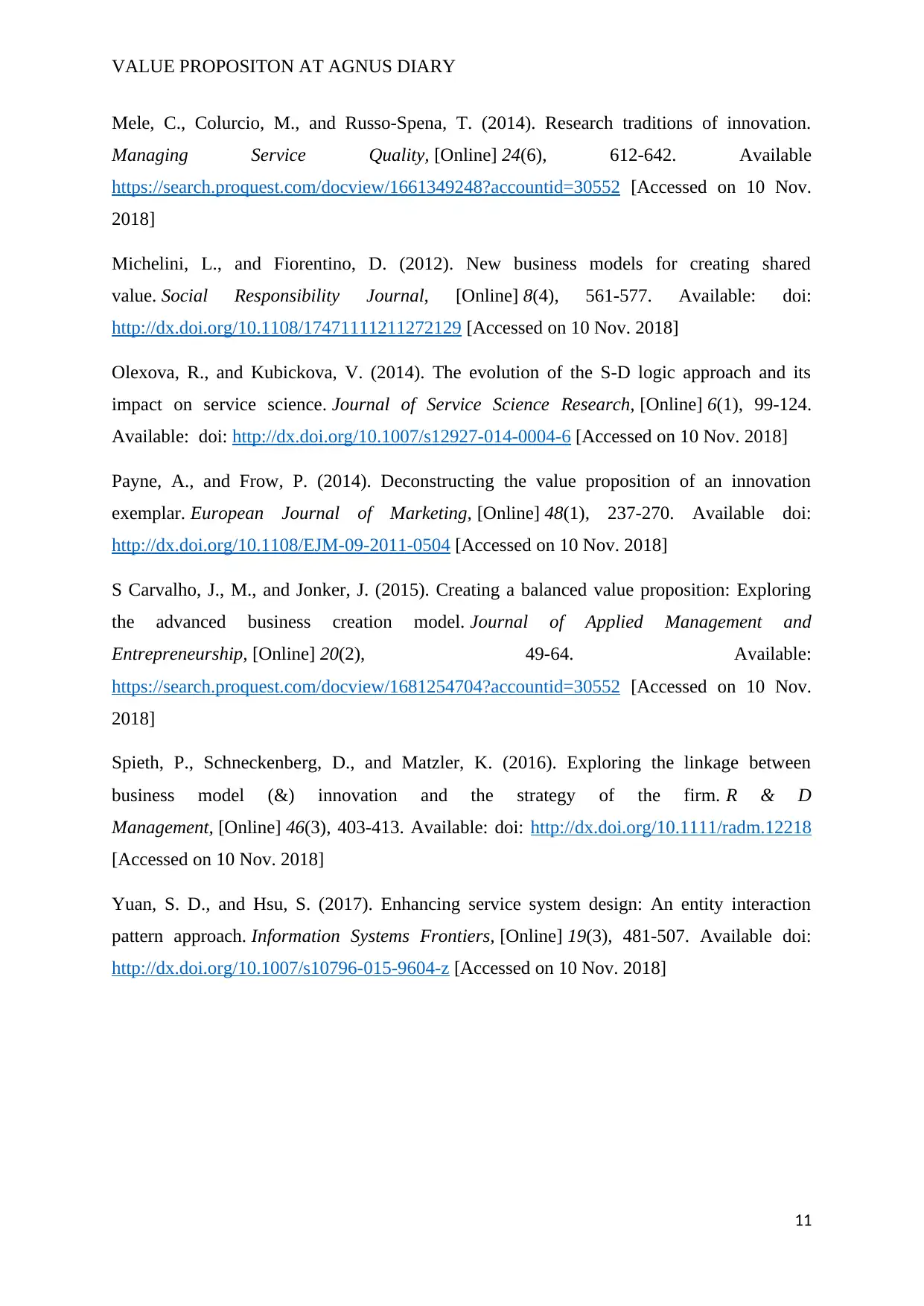
VALUE PROPOSITON AT AGNUS DIARY
Mele, C., Colurcio, M., and Russo-Spena, T. (2014). Research traditions of innovation.
Managing Service Quality, [Online] 24(6), 612-642. Available
https://search.proquest.com/docview/1661349248?accountid=30552 [Accessed on 10 Nov.
2018]
Michelini, L., and Fiorentino, D. (2012). New business models for creating shared
value. Social Responsibility Journal, [Online] 8(4), 561-577. Available: doi:
http://dx.doi.org/10.1108/17471111211272129 [Accessed on 10 Nov. 2018]
Olexova, R., and Kubickova, V. (2014). The evolution of the S-D logic approach and its
impact on service science. Journal of Service Science Research, [Online] 6(1), 99-124.
Available: doi: http://dx.doi.org/10.1007/s12927-014-0004-6 [Accessed on 10 Nov. 2018]
Payne, A., and Frow, P. (2014). Deconstructing the value proposition of an innovation
exemplar. European Journal of Marketing, [Online] 48(1), 237-270. Available doi:
http://dx.doi.org/10.1108/EJM-09-2011-0504 [Accessed on 10 Nov. 2018]
S Carvalho, J., M., and Jonker, J. (2015). Creating a balanced value proposition: Exploring
the advanced business creation model. Journal of Applied Management and
Entrepreneurship, [Online] 20(2), 49-64. Available:
https://search.proquest.com/docview/1681254704?accountid=30552 [Accessed on 10 Nov.
2018]
Spieth, P., Schneckenberg, D., and Matzler, K. (2016). Exploring the linkage between
business model (&) innovation and the strategy of the firm. R & D
Management, [Online] 46(3), 403-413. Available: doi: http://dx.doi.org/10.1111/radm.12218
[Accessed on 10 Nov. 2018]
Yuan, S. D., and Hsu, S. (2017). Enhancing service system design: An entity interaction
pattern approach. Information Systems Frontiers, [Online] 19(3), 481-507. Available doi:
http://dx.doi.org/10.1007/s10796-015-9604-z [Accessed on 10 Nov. 2018]
11
Mele, C., Colurcio, M., and Russo-Spena, T. (2014). Research traditions of innovation.
Managing Service Quality, [Online] 24(6), 612-642. Available
https://search.proquest.com/docview/1661349248?accountid=30552 [Accessed on 10 Nov.
2018]
Michelini, L., and Fiorentino, D. (2012). New business models for creating shared
value. Social Responsibility Journal, [Online] 8(4), 561-577. Available: doi:
http://dx.doi.org/10.1108/17471111211272129 [Accessed on 10 Nov. 2018]
Olexova, R., and Kubickova, V. (2014). The evolution of the S-D logic approach and its
impact on service science. Journal of Service Science Research, [Online] 6(1), 99-124.
Available: doi: http://dx.doi.org/10.1007/s12927-014-0004-6 [Accessed on 10 Nov. 2018]
Payne, A., and Frow, P. (2014). Deconstructing the value proposition of an innovation
exemplar. European Journal of Marketing, [Online] 48(1), 237-270. Available doi:
http://dx.doi.org/10.1108/EJM-09-2011-0504 [Accessed on 10 Nov. 2018]
S Carvalho, J., M., and Jonker, J. (2015). Creating a balanced value proposition: Exploring
the advanced business creation model. Journal of Applied Management and
Entrepreneurship, [Online] 20(2), 49-64. Available:
https://search.proquest.com/docview/1681254704?accountid=30552 [Accessed on 10 Nov.
2018]
Spieth, P., Schneckenberg, D., and Matzler, K. (2016). Exploring the linkage between
business model (&) innovation and the strategy of the firm. R & D
Management, [Online] 46(3), 403-413. Available: doi: http://dx.doi.org/10.1111/radm.12218
[Accessed on 10 Nov. 2018]
Yuan, S. D., and Hsu, S. (2017). Enhancing service system design: An entity interaction
pattern approach. Information Systems Frontiers, [Online] 19(3), 481-507. Available doi:
http://dx.doi.org/10.1007/s10796-015-9604-z [Accessed on 10 Nov. 2018]
11
1 out of 11
Related Documents
Your All-in-One AI-Powered Toolkit for Academic Success.
+13062052269
info@desklib.com
Available 24*7 on WhatsApp / Email
![[object Object]](/_next/static/media/star-bottom.7253800d.svg)
Unlock your academic potential
Copyright © 2020–2025 A2Z Services. All Rights Reserved. Developed and managed by ZUCOL.





